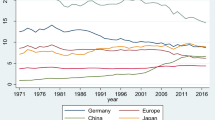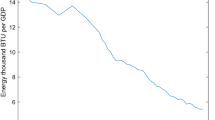Abstract
This paper estimates factor-specific technical change and input substitution using a structural approach. It contributes to the existing literature by introducing various technology drivers for factor productivities and by assessing the impact of endogenous technical change on the elasticity of substitution. The empirical results suggest that factor productivities are indeed endogenous. In addition, technology drivers are factor-specific. Whereas the R&D stock and machinery imports are important determinants of energy and capital productivity, the education stock is statistically related to labour productivity. The rate of energy-augmenting technical change is larger than that of either labour or capital. By contrast, the productivity of these two factors grows at similar rates. Estimates of the elasticity of substitution are within the range identified by previous literature. In addition, we show that endogenous technical change reduces substitution. Because the elasticity of substitution is lower than one, knowledge and human capital can ultimately have an energy-using effect. The estimated structure of endogenous technical change suggests that Integrated Assessment models focusing on energy-saving technical change might underestimate climate policy costs.
Similar content being viewed by others
Notes
Hicks neutral technical change can be represented as a parallel shift in isoquants. Factor-biased technical change shifts the slopes of the isoquants, thereby affecting the relative marginal product of inputs. Technical change is factor-augmenting if it increases the productivity of factors.
Given the focus of the paper, which is the identification of the endogenous determinants of factor-augmenting technical change, we decided to start with one of the simplest CES structure that has an empirical foundation.
Cost minimisation is also a standard assumption made in IA modelling literature. As in the IA modelling literature we also assume price-taking behaviour and therefore the unit cost function gives the price of final output, C(1; P K ,P L ,P E ) = P.
Small letters denote percentage changes, e.g. \( x = dX\,/\,X = dlnX \).
The time effect can also be made country-specific by interacting country dummies with the time trend. Although all of these specifications were estimated, the model with a common time trend was preferred because it is more parsimonious.
Data available from http://www.sourceoecd.org/
World Bank, 2006.
ANBERD—R&D Expenditure in Industry 2006 available from http://www.sourceoecd.org/
Data available from http://www.sourceoecd.org/
Education Expenditures by Country, Nature, Resource Category, and Level of Education Vol. 2006 issue 01.
A higher depreciation rate was also experimented, yielding very similar results.
The correlation between these three variables is low and therefore they could be included simultaneously.
We used an iterative selection technique that drops regressors one by one, selecting those with the lowest significance level, until all variables are significant.
As in Table 2, we reject that labour and either capital or energy have the same rate of factor-augmentation, but we could not reject that energy and capital have the same growth rate.
Bootstrap methods provide an alternative to inference based on parametric assumptions ,when those assumptions are in doubt.
References
Acemoglu, D. (2002). Directed technical change. Review of Economic Studies, 69, 781–809.
Arrow, J. K. (1962). The economic implications of learning by doing. The Review of Economic Studies, 29, 155–173.
Barro, R., & Sala-i-Martin, X. (2004). Economic growth. Cambridge: MIT Press.
Binswanger, H. P., & Ruttan, V. W. (1978). Induced innovation: technology, institutions and development. Baltimore: John Hopkins University Press.
Boone, L.H., & Kemball-Cook, D. (1992). Fossil Fuel Demand for Nine OECD Countries. Discussion Paper DP 21–92, Centre for Economic Forecasting, London Business School.
Bovenberg, A.-L., & Smulders, S. (1995). Environmental quality and pollution augmenting technological change in a two sectors endogenous growth model. Journal of Public Economics, 57, 369–391.
Brock, W.A., and Taylor M.S. (2004). Economic growth and the environment: a review of theory and empirics, NBER Working Paper, No. W10855.
Cameron, G., Proudman, J., & Redding, S. (2005). Technological convergence, R&D, trade and productivity growth. European Economic Review, 49(3), 775–807.
Carraro, C., & Siniscalco, D. (1994). Technical innovation and environmental protection, environmental policy reconsidered: the role of technological innovation. European Economic Review, 38, 545–554.
Carraro, C., & Galeotti, M. (1996). WARM: a European model for energy and environmental analysis. Environmental Modelling and Assessment, 1, 171–189.
Carraro, C., De Cian, E., & M. Tavoni (2009). “Human capital formation and global warming mitigation: evidence from an integrated assessment model”, CESifo Working Paper Series, No. 2874.
Carraro, C., De Cian, E., Nicita, L., Massetti, E., & Verdolini, E. (2010). Environmental policy and technical change: a survey. International Review of Environmental and Resource Economics, 4, 163–219.
Carraro, C., Massetti, E., & Nicita, L. (2009). How does climate policy affect technical change? An analysis of the direction and pace of technical progress in a climate–economy model. The Energy Journal, 30(2), 7–38.
Caselli, F. (2005). Accounting for cross country income differences. In P. Aghion and S. Durlaf (Eds.), Handbook of Economic Growth. Elsevier, (1).
Coe, D. T., & Helpman, E. (1995). International R&D spillovers. European Economic Review, 39, 859–887.
Coe, D. T., Helpman, E., & Hoffmaister, W. (1997). North–south R&D spillovers. Economic Journal, 07, 134–49.
David, P. A., & van de Klundert, T. (1965). Biased efficiency growth and capital-labor substitution in the U.S., 1899–1960. American Economic Review, 55(3), 357–394.
Delong, J. B., & Summers, H. L. (1991). Equipment investment and economic growth. The Quarterly Journal of Economics, 106(2), 445–502.
Edenhofer, O., Bauer, N., & Kriegler, E. (2005). The impact of technological change on climate protection and welfare: insights from the model MIND. Ecological Economics, 54, 277–292.
Edenhofer Ottmar, Kay Lessmann, Claudia Kemfert, Micheal Grubb and Jonathan Koehler (2006). “Technological Change: Exploring its Implications for the Economics of Atmospheric Stabilization”, The Energy Journal: Special Issue, Endogenous Technological Change and the Economics of Atmospheric Stabilization, Vol. 9.
Engelbrecht, H. J. (1997). International R&D spillovers, human capital and productivity in OECD economies: an empirical investigation. European Economic Review, 41, 1479–1488.
Kenneth, G., Newell, R., & Palmer, K. (2009). Energy efficiency economics and policy. Annual Review of Resource Economics, 1(14), 1–23.
Gerlagh, R. (2008). A climate–change policy induced shift from innovations in carbon-energy production to carbon-energy savings. Energy Economics, 30, 425–448.
Greenwood, J., Yorukoglu, M. (1997). 1974. Carnegie-Rochester Conference Series on Public Policy, North-Holland.
Griliches, Z. (1980). Returns to R&D expenditure in the private sector. In K. Kendrick & B. Vaccara (Eds.), New developments in productivity measurement. Chicago: Chicago University Press.
Grossman, G., & Helpman, E. (2001). Innovation and growth in the global economy. Cambridge: MIT Press.
Grubb, M., Köhler, J., & Anderson, D. (2002). Induced technical change in energy and environmental modelling: analytic approaches and policy implications. Annual Review of Energy and the Environment, 27, 271–308.
Goulder, L. H., & Schneider, S. H. (1999). Induced technological change and the attractiveness of CO2 abatement policies. Resource and Energy Economics, 21, 211–253.
Heston, A., Summers, R., & Aten, B. (2006). Penn World Table Version 6.2, Center for International Comparisons of Production, Income and Prices at the University of Pennsylvania, September 2006.
Jorgenson, D. W., & Fraumeni, B. M. (1981). Relative prices and technical change. In E. Berndt & B. Field (Eds.), Modeling and measuring natural resource substitution (pp. 17–47). Cambridge: MIT Press.
Jorgenson, D. W., & Fraumeni, B. (1992). Investment in education and U.S. economic growth. Scandinavian Journal of Economics, 94, S51–S70.
Jorgenson, D. W., & Wilcoxen, P. J. (1990). Intertemporal general equilibrium modelling of the US environmental regulation. Journal of Policy Modelling, 12, 715–44.
Kendrick, J. W. (1956). Productivity trends: capital and labor. The Review of Economics and Statistics, 38(3), 248–257.
Lucas, R. (1988). On the mechanics of economic development. Journal of Monetary Economics, 22, 3–42.
Lopez, R. (1994). The environment as a factor of production: the effects of economic growth and trade liberalization. Journal of Environmental Economics and Management, 27, 163–184.
Andreas, L. (2002). Technological change in economic models of environmental policy: a survey. Ecological Economics, 43(2–3), 105–126.
Mansfield, E. (1979). Rates of returns from industrial R&D. American Economic Review, 55, 310–322.
Mansfield, E. (1980). Basic research and productivity increase in manufacturing. American Economic Review, 70, 863–73.
Markandya, A., & Pedroso-Galinato, S. (2007). How substitutable is natural capital? Environmental Resource Economics, 37, 297–312.
Nadiri, M. I. (1970). Some approaches to the theory and measurement of total factor productivity: a survey. Journal of Economic Literature, 8, 1137–77.
Otto, V. M., Löschel, A., & Dellink, R. (2007). Energy biased technical change: a CGE analysis. Resource and Energy Economics, 29(2), 137–158.
Pindyck, R. S. (1979). Interfuel Substitution and the industrial demand for energy: an international comparison. The Review of Economics and Statistics, 61(2), 169–79.
Popp, D. (2004). ENTICE: endogenous technical change in the DICE model of global warming. Journal of Environmental Economics and Management, 48, 742–768.
Romer, P. M. (1986). Increasing return to scale and long-run growth. Journal of Political Economy, 94, 1002–1037.
Romer, P. M. (1990). Endogenous technological change. Journal of Political Economy, 98, 71–102.
Rosenberg, N. (1983). Inside the black box: technology and economics, Cambridge University Press.
Sanstad, A. H., Roy, J., & Sathaye, J. A. (2008). Estimating energy-augmenting technological change in developing country industries. Energy Economics, 28, 720–729.
Slade, M. E. (1989). Modeling stochastic and cyclical components of technical change: an application of the Kalman Filter. Journal of Econometrics, 41(3), 363–383.
Smulders, Sjak, & de Nooij, Michiel. (2003). The impact of energy conservation on technology and economic growth. Resource and Energy Economics, 25(1), 59–79.
Solow, R.M. (1957). Technical change and the aggregate production function. Review of Economics and Statistics, 39, 312–320. Sue Wing 2033.
Sue Wing, I. (2006). Representing induced technological change in models for climate policy analysis. Energy Economics, 28(5–6), 539–562.
Sue Wing, I., & Eckaus, J. A. (2007). The decline in U.S. energy intensity: its origins and implications for long-run CO2 emission projections. Energy Policy, 35, 5267–5286.
van der Werf, E. (2008). Production functions for climate policy modelling: an empirical analysis. Energy Economics, 30(6), 2964–2979.
Author information
Authors and Affiliations
Corresponding author
Appendices
Appendix I
Table 4 provides descriptive statistics of the main variables.
Appendix II
This Appendix reports the same results as in the main text from Tables 1 to 4, but with bootstrap standard errors. Results confirm the validity of the inference analysis carried out in the main text is valid.
Rights and permissions
About this article
Cite this article
Carraro, C., De Cian, E. Factor-Augmenting Technical Change: An Empirical Assessment. Environ Model Assess 18, 13–26 (2013). https://doi.org/10.1007/s10666-012-9319-1
Received:
Accepted:
Published:
Issue Date:
DOI: https://doi.org/10.1007/s10666-012-9319-1




